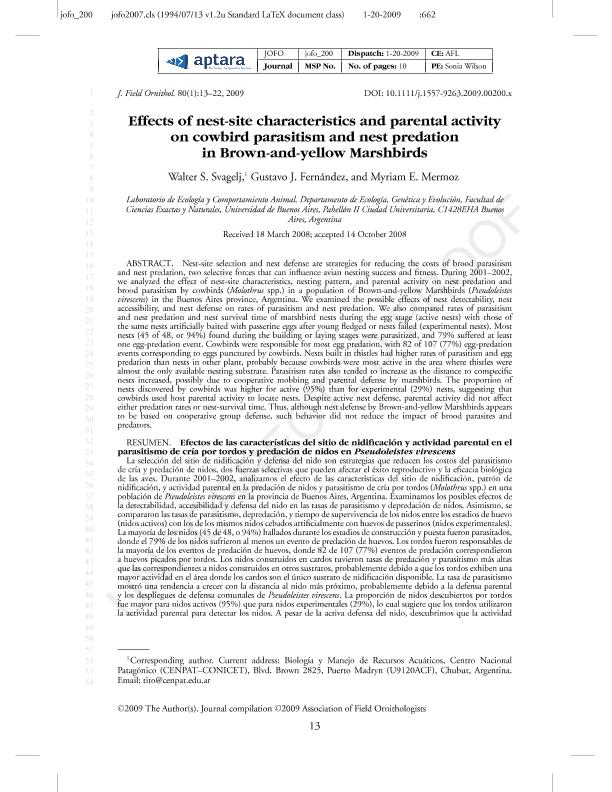Mostrar el registro sencillo del ítem
dc.contributor.author
Svagelj, Walter Sergio

dc.contributor.author
Fernandez, Gustavo Javier

dc.contributor.author
Mermoz, Myriam Emilia

dc.date.available
2020-01-27T20:24:58Z
dc.date.issued
2009-03
dc.identifier.citation
Svagelj, Walter Sergio; Fernandez, Gustavo Javier; Mermoz, Myriam Emilia; Effects of nest-site characteristics and parental activity on cowbird parasitism and nest predation in Brown-and-yellow Marshbirds; Wiley Blackwell Publishing, Inc; Journal Of Field Ornithology; 80; 1; 3-2009; 9-18
dc.identifier.issn
0273-8570
dc.identifier.uri
http://hdl.handle.net/11336/95899
dc.description.abstract
Nest-site selection and nest defense are strategies for reducing the costs of brood parasitism and nest predation, two selective forces that can influence avian nesting success and fitness. During 2001-2002, we analyzed the effect of nest-site characteristics, nesting pattern, and parental activity on nest predation and brood parasitism by cowbirds (Molothrus spp.) in a population of Brown-and-yellow Marshbirds (Pseudoleistes virescens) in the Buenos Aires province, Argentina. We examined the possible effects of nest detectability, nest accessibility, and nest defense on rates of parasitism and nest predation. We also compared rates of parasitism and nest predation and nest survival time of marshbird nests during the egg stage (active nests) with those of the same nests artificially baited with passerine eggs after young fledged or nests failed (experimental nests). Most nests (45 of 48, or 94%) found during the building or laying stages were parasitized, and 79% suffered at least one egg-predation event. Cowbirds were responsible for most egg predation, with 82 of 107 (77%) egg-predation events corresponding to eggs punctured by cowbirds. Nests built in thistles had higher rates of parasitism and egg predation than nests in other plant, probably because cowbirds were most active in the area where thistles were almost the only available nesting substrate. Parasitism rates also tended to increase as the distance to conspecific nests increased, possibly due to cooperative mobbing and parental defense by marshbirds. The proportion of nests discovered by cowbirds was higher for active (95%) than for experimental (29%) nests, suggesting that cowbirds used host parental activity to locate nests. Despite active nest defense, parental activity did not affect either predation rates or nest-survival time. Thus, although nest defense by Brown-and-yellow Marshbirds appears to be based on cooperative group defense, such behavior did not reduce the impact of brood parasites and predators.
dc.format
application/pdf
dc.language.iso
eng
dc.publisher
Wiley Blackwell Publishing, Inc

dc.rights
info:eu-repo/semantics/openAccess
dc.rights.uri
https://creativecommons.org/licenses/by-nc-sa/2.5/ar/
dc.subject
CONCEALMENT
dc.subject
EGG LOSSES
dc.subject
EXPERIMENTAL NESTS
dc.subject
HOST ACTIVITY
dc.subject
MOLOTHRUS SPP
dc.subject
NEST-SEARCHING METHOD
dc.subject
PARTIAL NEST PREDATION
dc.subject.classification
Ecología

dc.subject.classification
Ciencias Biológicas

dc.subject.classification
CIENCIAS NATURALES Y EXACTAS

dc.title
Effects of nest-site characteristics and parental activity on cowbird parasitism and nest predation in Brown-and-yellow Marshbirds
dc.title
Efectos de las características del sitio de nidificación y actividad parental en el
parasitismo de cría por tordos y predación de nidos en Pseudoleistes virescens
dc.type
info:eu-repo/semantics/article
dc.type
info:ar-repo/semantics/artículo
dc.type
info:eu-repo/semantics/publishedVersion
dc.date.updated
2019-12-12T14:46:19Z
dc.journal.volume
80
dc.journal.number
1
dc.journal.pagination
9-18
dc.journal.pais
Reino Unido

dc.journal.ciudad
Londres
dc.description.fil
Fil: Svagelj, Walter Sergio. Universidad de Buenos Aires. Facultad de Ciencias Exactas y Naturales. Departamento de Ecología, Genética y Evolución. Laboratorio de Ecología y Comportamiento Animal; Argentina. Consejo Nacional de Investigaciones Científicas y Técnicas. Oficina de Coordinación Administrativa Ciudad Universitaria. Instituto de Ecología, Genética y Evolución de Buenos Aires. Universidad de Buenos Aires. Facultad de Ciencias Exactas y Naturales. Instituto de Ecología, Genética y Evolución de Buenos Aires; Argentina
dc.description.fil
Fil: Fernandez, Gustavo Javier. Universidad de Buenos Aires. Facultad de Ciencias Exactas y Naturales. Departamento de Ecología, Genética y Evolución. Laboratorio de Ecología y Comportamiento Animal; Argentina. Consejo Nacional de Investigaciones Científicas y Técnicas. Oficina de Coordinación Administrativa Ciudad Universitaria. Instituto de Ecología, Genética y Evolución de Buenos Aires. Universidad de Buenos Aires. Facultad de Ciencias Exactas y Naturales. Instituto de Ecología, Genética y Evolución de Buenos Aires; Argentina
dc.description.fil
Fil: Mermoz, Myriam Emilia. Universidad de Buenos Aires. Facultad de Ciencias Exactas y Naturales. Departamento de Ecología, Genética y Evolución. Laboratorio de Ecología y Comportamiento Animal; Argentina. Consejo Nacional de Investigaciones Científicas y Técnicas. Oficina de Coordinación Administrativa Ciudad Universitaria. Instituto de Ecología, Genética y Evolución de Buenos Aires. Universidad de Buenos Aires. Facultad de Ciencias Exactas y Naturales. Instituto de Ecología, Genética y Evolución de Buenos Aires; Argentina
dc.journal.title
Journal Of Field Ornithology

dc.relation.alternativeid
info:eu-repo/semantics/altIdentifier/doi/http://dx.doi.org/10.1111/j.1557-9263.2009.00200.x
dc.relation.alternativeid
info:eu-repo/semantics/altIdentifier/url/https://onlinelibrary.wiley.com/doi/full/10.1111/j.1557-9263.2009.00200.x
Archivos asociados
